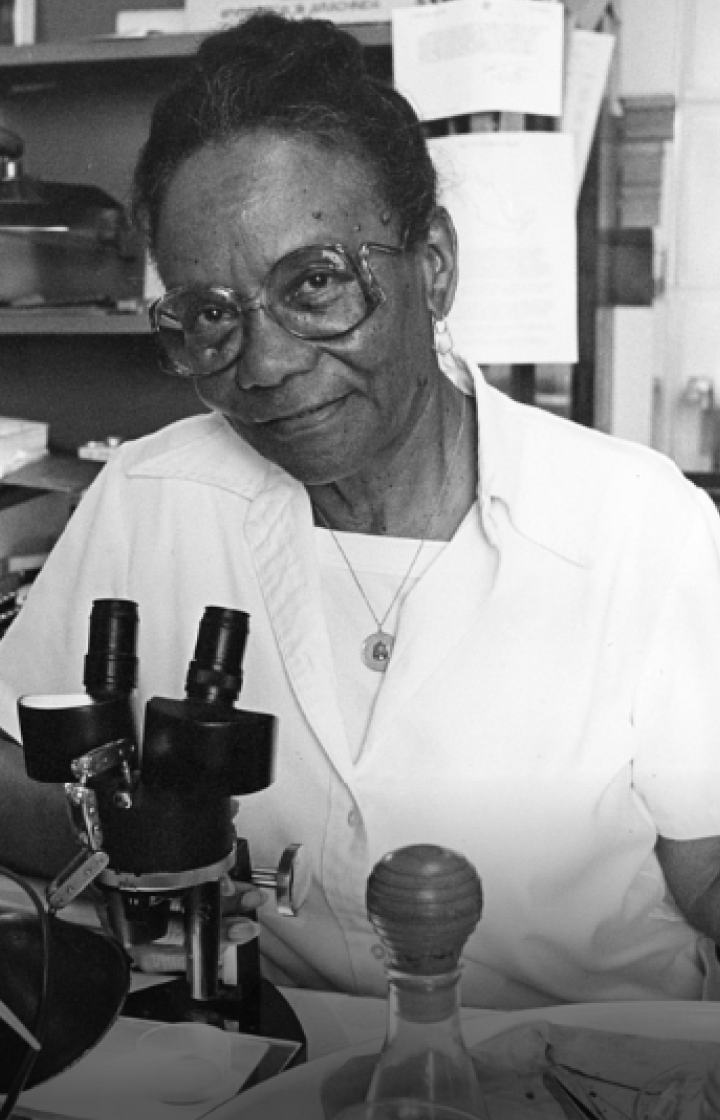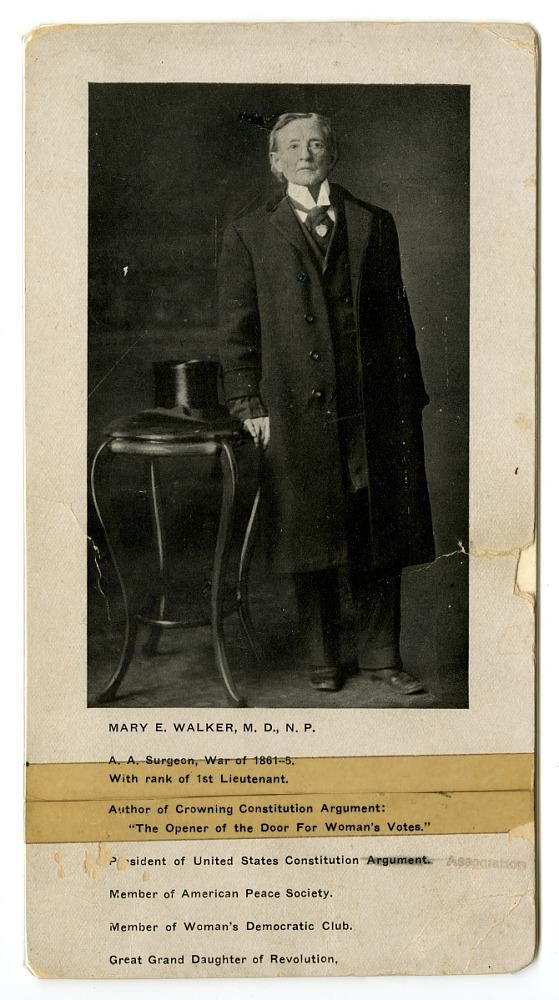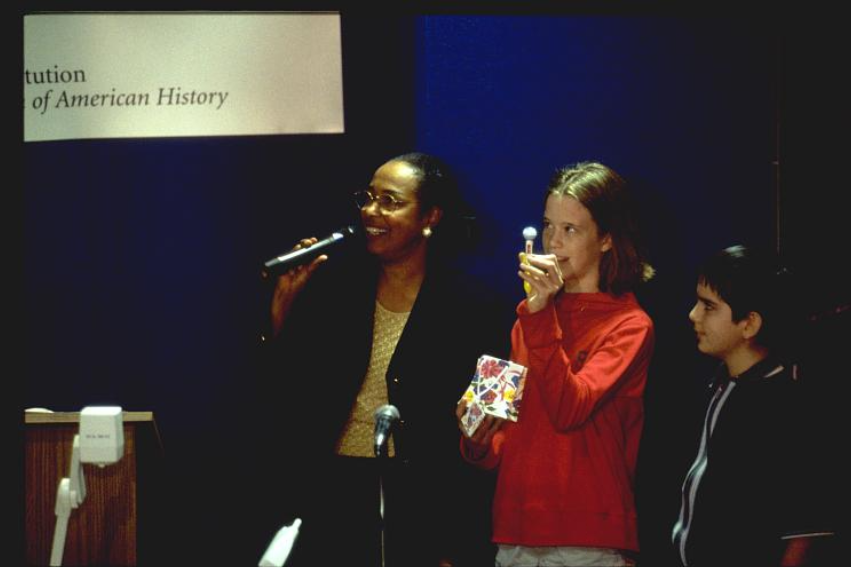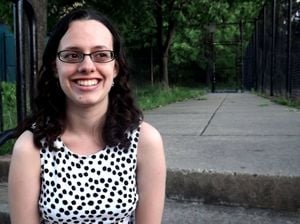AMERICAN WOMEN'S HISTORY INITIATIVE
Hear Voices of Women Leaders in Science, Technology, and Innovation
Ophthalmologist Dr. Patricia Bath worked to bring healthcare to underserved communities and teach girls about STEM.
/https://tf-cmsv2-smithsonianmag-media.s3.amazonaws.com/blogging/featured/Bath_and_students.png)
According to the National Science Foundation, in 2017 only 15% of women were employed in science and engineering careers. By contrast, 33% of men held jobs in these fields. Sharing the histories of women trailblazers in science can remind young women that they, too, can succeed. In recognition and celebration of female leaders in science and tech, Bloomberg New Voices and the Smithsonian's American Women's History Initiative recently joined together for our second co-sponsored conversation in "The Women in the Room" series. Our program explored women in science in the past, present, and future. It also showed how we at the Smithsonian, and our collaborators at Bloomberg New Voices, are working to change the future.
Smithsonian Secretary Lonnie G. Bunch III welcomed viewers by highlighting former Smithsonian researcher Sophie Lutterlough. In 1943, Lutterlough was hired as the first woman elevator operator at our National Museum of Natural History. She studied insects on her lunch break. After 14 years as an elevator operator, she became an entomology research assistant at the museum.

Katherine Ott, curator in the Division of Medicine and Science at our National Museum of American History, shared the stories of women in science. One example is Mary Walker, a Civil War surgeon. Walker wore pants, since they were easier to work in, and kept her own last name after marriage. She spoke out for women's rights and the abolition of slavery.
Ott shared that many of women's scientific achievements have likely been lost to time. She said, "Women's stories have been so buried, erased, and untended [that] the 'first' of something is likely long lost to us. Today's researcher or practitioner is able to do what she does because of the hundreds of thousands of people who came before her."

The program also included an exploration of Picturing Women Inventors, an exhibition at our National Museum of American History. The exhibition highlights the motivations, challenges, and accomplishments of 20th and 21st century innovators. Alison Oswald, archivist at our National Museum of American History, spoke about ophthalmologist Dr. Patricia Bath. In 1986, Bath invented a probe to make cataract surgery more accurate and less invasive. She worked to bring healthcare to underserved communities and teach girls about STEM (science, technology, engineering, and mathematics).

Hosted by Bloomberg news anchor Alix Steel, The Woman the Room: Science, Technology, and Innovation included a panel with several scientific leaders of today: Kathrin Jansen, Ph.D., Senior Vice President, Head of Vaccine Research and Development at Pfizer; Fei-Fei Li, Ph.D., Sequoia Professor in the Computer Science Department at Stanford University and Denning Co-Director of Stanford's Human-Centered AI Institute; Priscilla Chan, MD, co-founder and co-CEO at Chan Zuckerberg Initiative; and Anne Schuchat, MD, Principal Deputy Director of the CDC.
Chan shared the Chan Zuckerberg Initiative's work to support COVID-19 education and vaccine acceptance. Their work particularly focuses in communities of color that have been deeply impacted by COVID-19 but often overlooked in large scale public health efforts. One example is their new Made to Save campaign. The campaign works to increase access to vaccines in communities of color, to address vaccination concerns, and to encourage people to get vaccinated when it is available. It's an education and awareness building effort, as well as a community engagement effort. Made to Save is also providing resources to trusted local community organizations for outreach programs around vaccines.
Chan said, "In our country we've had a long history of systemic inequities, in particular for Black, Latinx, Indigenous communities...This is a scenario where every additional person who gets vaccinated makes their entire community safer." It has been found that trusted community leaders are the most important voices in sharing information in communities.
To close the program, audiences had an opportunity to learn about efforts to train and tell the stories of future women leaders in technology and science. Speakers included Laura Zelenko, senior executive editor at Bloomberg News; Evelyn Erskine of Bloomberg corporate philanthropy; and Ellen Stofan, Ph.D., Under Secretary for science and research at Smithsonian Institution.
Erskine spoke about a partnership between Bloomberg and the nonprofit Break Through Tech, wherein Bloomberg offers young women studying STEM development training, workshops, and opportunities to showcase their technical skills.
Stofan spoke about how past women in STEM inspire her. She said, "In my own path in science, hearing stories of people who studied geology in our solar system made me say 'that's what I want to do.' But when I was an intern at NASA, very few people looked like me." Stofan shared how our American Women History Initiative, Because of Her Story, shares the stories of these innovators and experts through exhibitions and programs. One example is the Picturing Women Inventors poster exhibition, available online and at several Smithsonian Affiliate museums. We are launching a forthcoming public health campaign, in partnership with museums and grassroots organization, to increase awareness of the benefits of vaccines in the past and present. We help educate the next generation of women leaders through paid internships across the Smithsonian.

